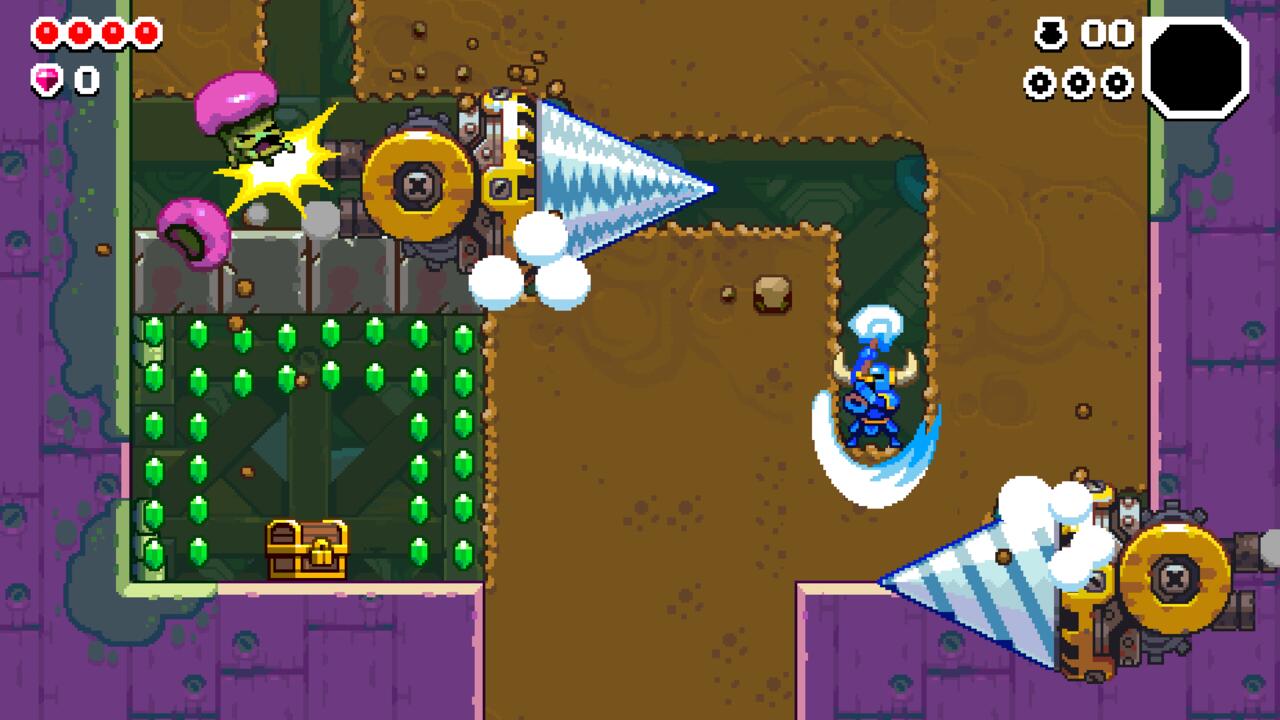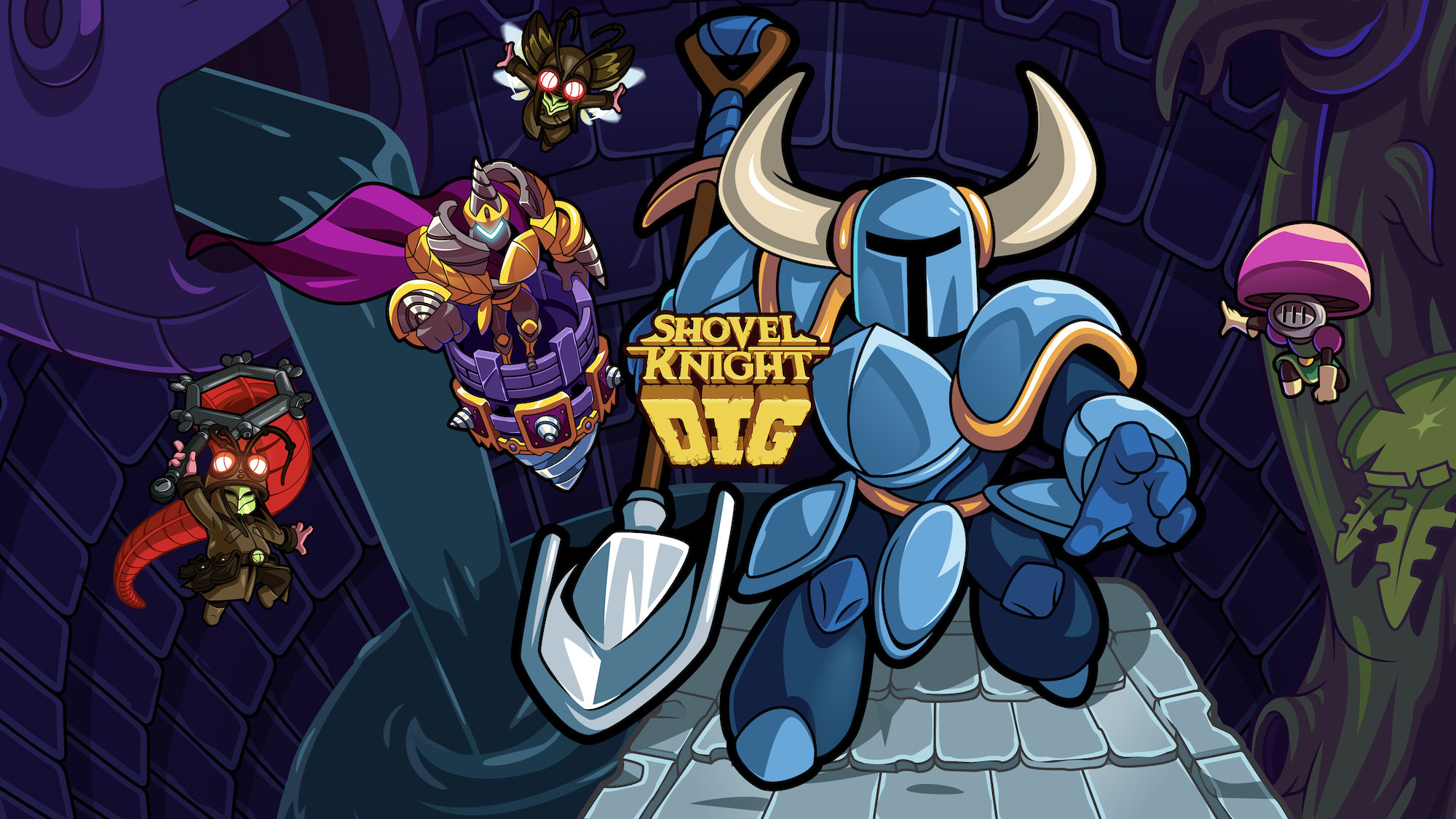Shovel Knight Dig is very unlike the retro action game that catapulted the character into indie royalty. But in a strange way, it feels like a natural extension of that game’s mechanics and concepts. If the original Shovel Knight evoked the feeling of a lost platformer from the NES era, Shovel Knight Dig feels like a disruptive follow-up that boldly charts new ground for the series, instead of hewing closely to the source material. This isn’t actually Shovel Knight 2, but it could have been.
The distinction is interesting because this game is another developer riffing on the Shovel Knight concept, but under the watchful eye of the original studio, Yacht Club Games. Nitrome has liberally borrowed some key elements from Shovel Knight, but this isn’t a spin-off in the same way that last year’s Shovel Knight: Pocket Dungeon was. It doesn’t feel like the character is being transplanted into an entirely new genre; instead, it’s reimagining what can be done within a similar framework and with the same level of mechanical precision.
Put simply, Shovel Knight Dig is a vertical roguelike, having you dig your way down into the depths of the underground to confront the nefarious Drill Knight, who has stolen something valuable from our hero. The story is slight and simple, and although Drill Knight’s gang of “Hexcavators” is no match for the sheer wordplay bliss of The Order of No Quarter in terms of naming conventions, it works well enough.
The new structure recontextualizes the game, but it’s still a platformer at heart, and it still controls remarkably like the original Shovel Knight. Lots of enemies and even bosses reappear in this game, too. They behave in the ways you’d expect, but with subtle differences to reflect the new mechanics of digging your way underground. It’s like a magic trick: over and over you’ll see things that are the same, but also different.
As a roguelike, most of your time is spent committing to individual runs, which you initiate by diving into a massive hole in the ground. Depending on your luck and skill, those runs can last anywhere from a few minutes to a half-hour. A massive machine is bearing down on the stage as you progress, threatening to destroy you, so you can’t take too much time planning your perfect route or mopping up every enemy. When you’re on the main path, you need to be making constant progress downward, while dealing with enemy encounters and collecting gems and gears.
The gems are the persistent part of the roguelike, letting you buy new relics that randomly appear in the stages, as well as permanent upgrades like extra carry slots and armor. Golden gears, three per sub-stage, are littered through the procedurally generated stages in spots that are a little harder to reach and require some creative problem-solving. You get greater rewards for collecting more gears, and if you get all three you can choose between a full heal and a random relic. Stages also have multiple side rooms where you can take part in a quick challenge for extra gems or find a vendor, and every stage has multiple breakable walls that trigger when you hit a weak point–absolutely vital to uncover secrets and find collectibles.
All these disparate elements are a lot to take in, and it was hard to find my footing while I learned the game’s new rhythms and underpinning ideas. It doesn’t do much to explain itself, letting you learn by doing, but in my case that meant doing a lot of the first stage over and over again. Despite this, it always feels inviting to take on one more run, and it’s easy to lose yourself in plumbing the depths. Before long I went from struggling to even reach the first boss to easily dispatching him and moving on.
That sense of discovery lasts through the whole game, as each of the stages introduces new enemy types and even dirt to dig through. A fiery stage, for example, has patches of flammable coal-like dirt that will burn up in a cascading pattern if one of the fire-based enemies sets it ablaze. These dirt types get wildly creative in later stages: A magic-based stage had soil that acted as portals, and others that would shoot you in a straight line and ricochet off the walls. These combine into platforming challenges that are so fine-tuned that they feel handcrafted, despite being procedurally generated.
Learning a brand-new set of rules and wrinkles for each stage could be off-putting, but it’s eased by the ability to buy shortcuts into stages. This being a roguelike, you’ll probably want a fresh run from the top to accumulate enough upgrades to actually finish the game. But for the purposes of learning the ins and outs of a new environment, it’s a handy tool. If you just need to put an area through its paces, you can also turn on the wealth of accessibility options, which offer everything from increased damage and health to turning down the game speed. There’s no penalty for turning these on, and the game seems content to just let you have fun in whatever way you’d like.
The procedurally generated hooks even extend to the boss encounters themselves, changing the arena of battle in subtle ways each time you face a boss. My favorite of these was Tinker Knight, who retreats into a huge drilling machine for his second phase, peeking out of its many hatches to throw wrenches and presenting the opportunity to pogo off of him for damage. But the drilling machine itself was a mix and match of parts, with very different configurations every time I encountered it. It’s an impressive trick that makes every run feel that much more engaging.

All of this makes it thrilling when you’re on an especially good run. After some key upgrades in the earlier stages, I found myself sweeping my way through the later stages, having to learn new elements on the fly, and surprising myself when I finished it. That breathless sense of bareknuckle platforming followed by the relief and joy of accomplishment, like I had just gotten away with something I shouldn’t have, was one of my favorite gaming experiences this year. Even so, I don’t feel done. Branching paths means there are environments and bosses I haven’t even encountered yet, and I still want to track down more upgrades and armor types. I expect to be playing this one for a while.
In that way, it is very much a follow-up to Shovel Knight. The original retro platformer was tough-as-nails at parts, but all the more rewarding for it. Shovel Knight Dig takes everything that was great about that game and pulls it apart, reshaping it into something new that’s just as compelling and hard to put down.






